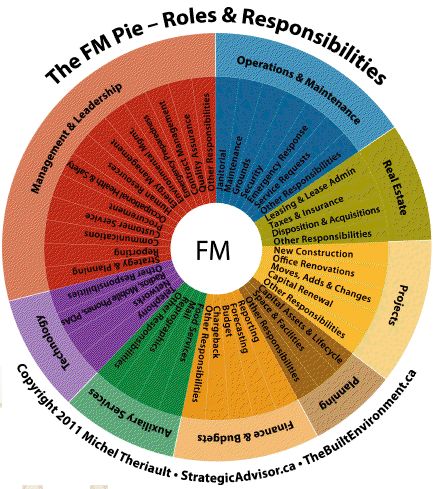Originally Published in Managing The Built Environment Blog June 2011
Unlike some professions, Facility Management encompasses many different roles and skills. Not everyone in the facility or property management profession are responsible for all of these roles. Some are responsible for specific functions as specialists, others are responsible for everything while some oversee all these roles through other specialists.
Regardless, it’s important to have a working knowledge of each one so you can effectively deal with your colleagues, manage staff or interface with external resources. A pie-shaped diagram is the easiest way to represent the broad responsibilities in the Facility Management Profession since FM includes so many different skills and responsibilities.
The FM Pie
This Pie Graph, which comes directly from the book “Managing Facilities & Real Estate” , shows the full range of Facility Management responsibilities. You could categorize them or subdivide them differently, but the fundamental responsibilities are all within this diagram. Depending on your role, you may be responsible for all these elements or just a few. You may also oversee them all, but have other experts on your team who focus on a specific aspect of the role. Some of these specific areas are actually represented by their own professions when performed as a distinct, separate role. For instance, a portion of the Pie covers both Commercial Property Management and Project Management. The Facility Management profession actually encompasses both of those functions.
From this, you can see that it is impossible for any given FM to have all the knowledge and skills to perform all the roles that are frequently expected of them. In addition, many of the responsibilities are non-technical, and they are in fact increasingly becoming strategic in nature. That’s why a Facility Manager has to rely on other experts, whether on their staff or as contractors and consultants. The profession of Facility Management isn’t just about the person with the Facility Manager title – it’s also about the large supporting cast of specialists, experts and other professionals.
Facility Management Scope
The Facility Manager’s most useful skills are Management & Leadership related – particularly the ability to develop strategy, communicate, lead and manage resources. The top FM’s in any large company rose to their level because of those skills.
The issue of scope and responsibility is further expanded when you consider typical portfolios, which can range from a single building to a regional or national portfolio and even an international portfolio of properties. Like many other profession, the larger the scope, the more people involved at different levels. Where a smaller property may have a single Facility Manager, a large portfolio may have a Vice President, Facilities, with several hundred staff under them.
This FM Pie has been very popular with FM’s around the world, who now have something to help explain the roles and responsibilities of an FM. It has even been translated to Czeck and Russian.
About the Author Michel Theriault is principal of Strategic Advisor, a Facility Management Consultant & Advisory firm that helps Facility Managers implement initiatives and improve results.
To download a full PDF version of the Pie, visit www.TheBuiltEnvironment.ca
Unlike some professions, Facility Management encompasses many different roles and skills. Not everyone in the facility or property management profession are responsible for all of these roles. Some are responsible for specific functions as specialists, others are responsible for everything while some oversee all these roles through other specialists.
Regardless, it’s important to have a working knowledge of each one so you can effectively deal with your colleagues, manage staff or interface with external resources. A pie-shaped diagram is the easiest way to represent the broad responsibilities in the Facility Management Profession since FM includes so many different skills and responsibilities.
The FM Pie
This Pie Graph, which comes directly from the book “Managing Facilities & Real Estate”, shows the full range of Facility Management responsibilities. You could categorize them or subdivide them differently, but the fundamental responsibilities are all within this diagram. Depending on your role, you may be responsible for all these elements or just a few. You may also oversee them all, but have other experts on your team who focus on a specific aspect of the role. Some of these specific areas are actually represented by their own professions when performed as a distinct, separate role. For instance, a portion of the Pie covers both Commercial Property Management and Project Management. The Facility Management profession actually encompasses both of those functions.
From this, you can see that it is impossible for any given FM to have all the knowledge and skills to perform all the roles that are frequently expected of them. In addition, many of the responsibilities are non-technical, and they are in fact increasingly becoming strategic in nature. That’s why a Facility Manager has to rely on other experts, whether on their staff or as contractors and consultants. The profession of Facility Management isn’t just about the person with the Facility Manager title – it’s also about the large supporting cast of specialists, experts and other professionals.
Facility Management Scope
The Facility Manager’s most useful skills are Management & Leadership related – particularly the ability to develop strategy, communicate, lead and manage resources. The top FM’s in any large company rose to their level because of those skills.
The issue of scope and responsibility is further expanded when you consider typical portfolios, which can range from a single building to a regional or national portfolio and even an international portfolio of properties. Like many other profession, the larger the scope, the more people involved at different levels. Where a smaller property may have a single Facility Manager, a large portfolio may have a Vice President, Facilities, with several hundred staff under them.
[blog_cta id=’69fdb0ae-1f37-40ef-9abe-798191d441dd’]

